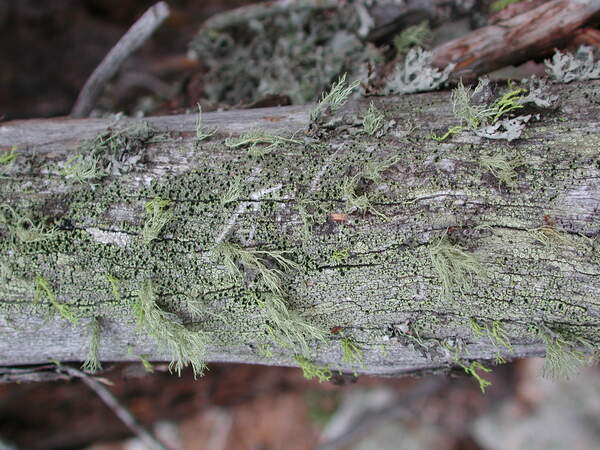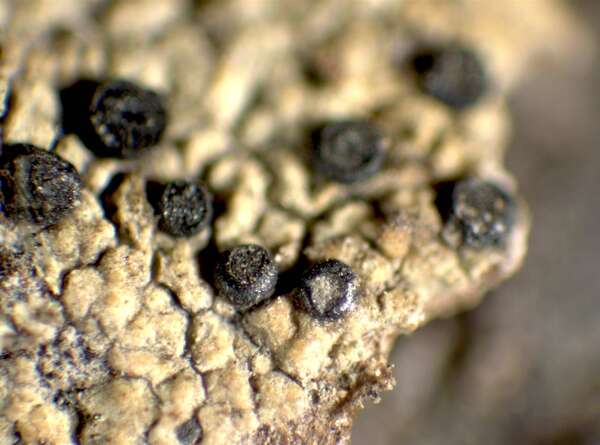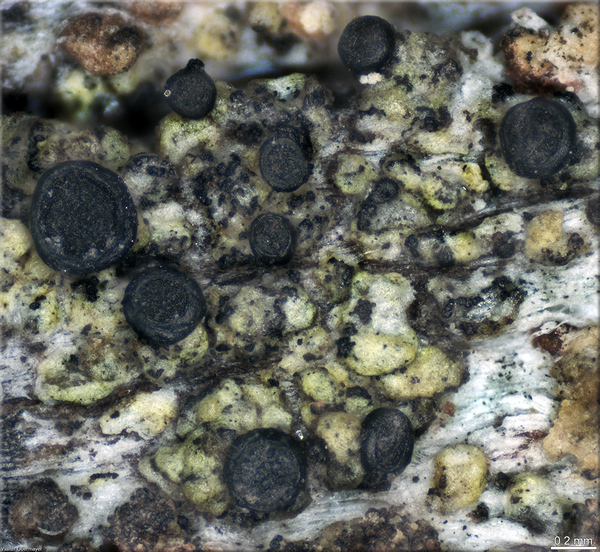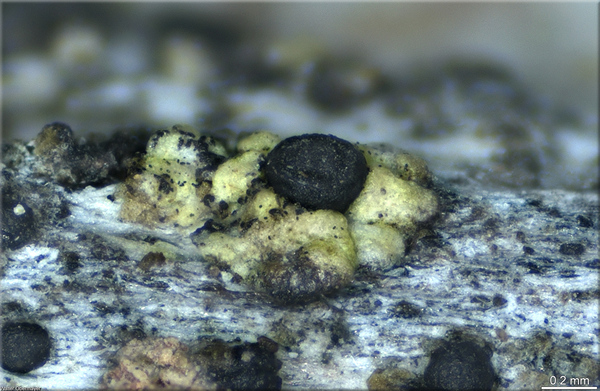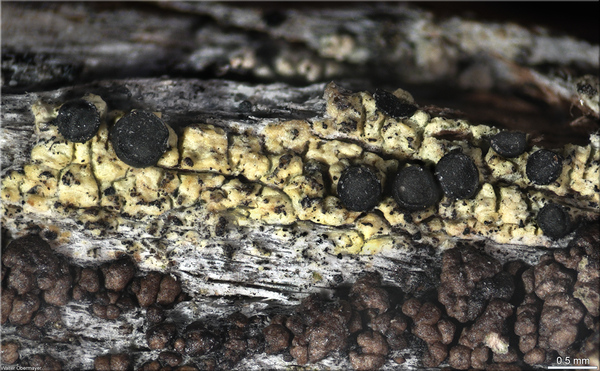Calicium pinicola (Tibell) M. Prieto & Wedin
Fungal Divers., 2016 (MB 817536). Basionym: Cyphelium pinicola Tibell - Svensk Bot. Tidskr., 63: 477, 1969.
Synonyms:
Distribution: N - TAA (Nascimbene 2005, Nascimbene & al. 2006e, 2007b, 2022, Nimis & al. 2015), Lomb (Puntillo & Puntillo 2009), Piem (Puntillo & Puntillo 2009, Ravera & al. 2021c), VA (TO 2405). S - Bas (Puntillo 2015), Cal (Puntillo 1994, 1996, Puntillo & Puntillo 2009), Si (Puntillo & Puntillo 2009).
Description: Thallus crustose, episubstratic or almost endosubstratic, most often verrucose, intensely greenish yellow. Cortex 11-30 µm thick, of hyaline, gelatinized hyphae, densely inspersed with small yellow crystals in lower part. Apothecia glossy black, epruinose, 0.4-0.7 mm across, sessile and constricted at base, with a well-developed, black proper margin which is usually somewhat inflexed over the black mazaedium. Exciple 45-95 µm wide laterally, of dark brown, sclerotized, irregularly interwoven hyphae, strongly thickened and 120-160(300) µm wide at base, extending deep down into the thallus; hypothecium dark, indistinctly delimited. Asci 8-spored, cylindrical to narrowly clavate, persisting until the spores are nearly mature, with 1- to 2-seriate spores. Ascospores 1-septate and slightly constricted at septum, dark brown, ellipsoid, 13-16 x 7-9 µm, the wall smooth in young spores, then with a few irregular and rather shallow fissures. Photobiont chlorococcoid. Spot tests: thallus K-, C-, KC-, P-. Chemistry: thallus with rhizocarpic acid. Note: a mainly temperate to southern boreal-montane lichen found on bark of conifers, and especially of Pinus, near the base of trunks, less confined to high altitudes than C. tigillare, from the Alps to the mountains of Sicily. It is included in the Italian red list of epiphytic lichens as “Vulnerable” (Nascimbene & al. 2013c).
Growth form: Crustose
Substrata: bark and lignum
Photobiont: green algae other than Trentepohlia
Reproductive strategy: mainly sexual
Commonnes-rarity: (info)
Alpine belt: absent
Subalpine belt: rare
Oromediterranean belt: absent
Montane belt: very rare
Submediterranean belt: absent
Padanian area: absent
Humid submediterranean belt: extremely rare
Humid mediterranean belt: absent
Dry mediterranean belt: absent
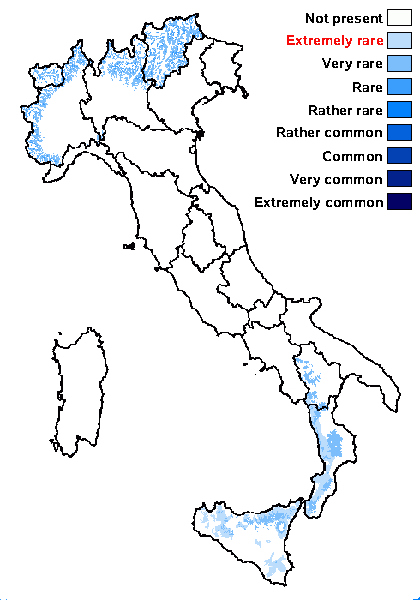
Predictive model
Herbarium samples
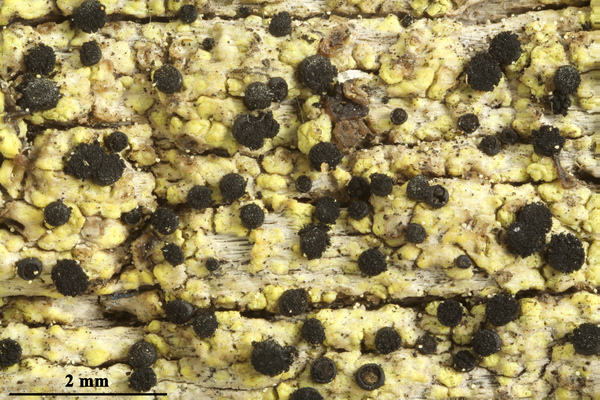

Felix Schumm - CC BY-SA4.0
[20959], Macedonia, SW Macedonia, Baba Mountain, northen side of Pelister, 1.7 km N of the summit, hiking path to the summit, 41°01'6.3'' N, 21°11'8.3'' E, 2050 m, on dead wood of Pinus peuce. Leg.M. Kaltenböck (no 106), 26.07.2017, det. Kaltenböck. DUPLA GRAECENSIA LICHENUM NR. 1111
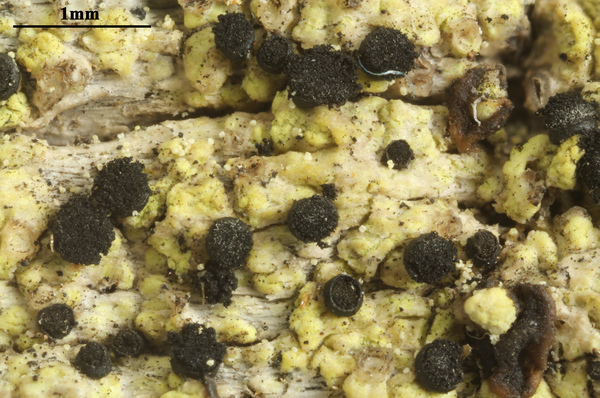

Felix Schumm - CC BY-SA4.0
[20959], Macedonia, SW Macedonia, Baba Mountain, northen side of Pelister, 1.7 km N of the summit, hiking path to the summit, 41°01'6.3'' N, 21°11'8.3'' E, 2050 m, on dead wood of Pinus peuce. Leg.M. Kaltenböck (no 106), 26.07.2017, det. Kaltenböck. DUPLA GRAECENSIA LICHENUM NR. 1111
Growth form: Crustose
Substrata: bark and lignum
Photobiont: green algae other than Trentepohlia
Reproductive strategy: mainly sexual
Commonnes-rarity: (info)
Alpine belt: absent
Subalpine belt: rare
Oromediterranean belt: absent
Montane belt: very rare
Submediterranean belt: absent
Padanian area: absent
Humid submediterranean belt: extremely rare
Humid mediterranean belt: absent
Dry mediterranean belt: absent

Predictive model
| Herbarium samples |


Felix Schumm - CC BY-SA4.0
[20959], Macedonia, SW Macedonia, Baba Mountain, northen side of Pelister, 1.7 km N of the summit, hiking path to the summit, 41°01'6.3'' N, 21°11'8.3'' E, 2050 m, on dead wood of Pinus peuce. Leg.M. Kaltenböck (no 106), 26.07.2017, det. Kaltenböck. DUPLA GRAECENSIA LICHENUM NR. 1111


 INDEX FUNGORUM
INDEX FUNGORUM
 GBIF
GBIF
 DOLICHENS
DOLICHENS

